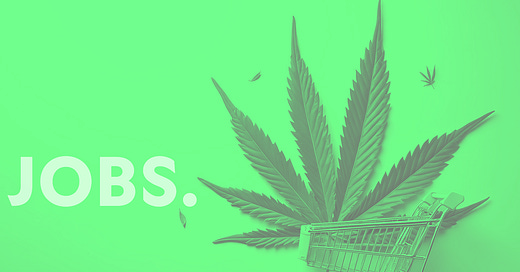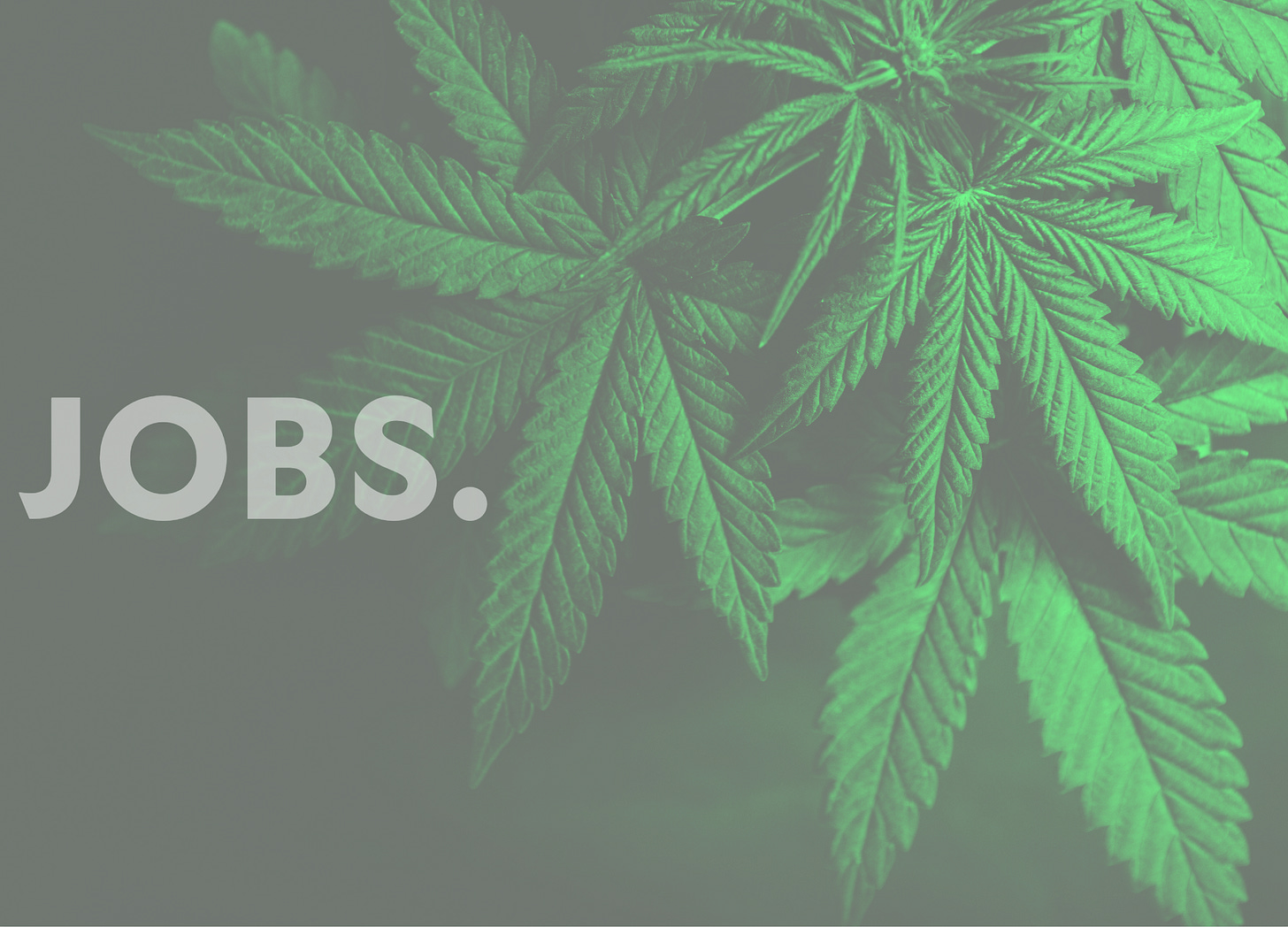Cannabis makes a lot of money. The law makes it too hard to spend that money on workers.
States have promised big things for jobs in legalizing marijuana and supporting hemp. Here is what is standing in their way and one way to address it.
The issue
Legal cannabis earns plenty of money and stands to make much more in the coming years. Half-in, half-out federal regulation makes it harder than it should be to create good jobs in the business.
Wait, what?
Jim Higdon sees being a good actor as a necessity in America’s growing legal cannabis industry.
“It’s important for us to understand that we’re in a profitable business that has been illegal in the past and that has caused a lot of damage to marginalized communities during the drug war,” said Higdon, the co-founder and chief communications officer for Cornbread Hemp. “We’re obligated by our success to help repair some of that damage.”
Cornbread has been called the fastest-growing hemp company in the United States, expanding by 3,000% between 2021 and 2024 through production of hemp gummies, creams, and other products. Cornbread recently received up to $700,000 in tax incentives from its home state of Kentucky to invest $1 million toward expanding and creating 50 more jobs in Louisville.
In a statement from Gov. Andy Beshear announcing the investment, Kentucky economic development officials noted that the average wage of Cornbread’s new jobs will be more than $26 per hour. According to MIT’s Living Wage Calculator, that is more than the estimated cost of living in Louisville for married workers with two children.
“We want the best people for the roles,” Higdon said. “Paying a premium . . . means we’re getting the best people.”
But still, “Some [companies] won’t deal with us because we’re legal but we’re not regulated,” Higdon said.
The Food and Drug Administration has declined to regulate hemp-based products1 as dietary supplements and punted the issue back to Congress, which made the hemp industry legal under federal law in 2018. So while Cornbread has received praise from Beshear—a potential 2028 presidential hopeful—and state investment, an insurer also recently declined to provide supplemental health insurance to Cornbread’s staff because of the perceived risk of the product it sells.
That situation is a good example of the workforce challenges facing legal cannabis in the United States. States and training providers have long pitched federal workforce officials to invest in the industry, which made $39 billion in revenue in 2024, a figure expected to double by 2030.2
Yet, when I was one of those federal officials, it was never clear to me if cannabis jobs were good jobs. Good jobs—where workers are paid well and treated well enough to stay and thrive—are a surer use of limited workforce resources, and they live up to the equitable workforce goals of advocates of marijuana legalization.
So over the past few weeks, I have communicated with state officials, industry experts, and employers like Cornbread to answer if there are good jobs in cannabis. What I found is that the cannabis industry is just legal enough to make money, but still illegal enough to be marginalized in a ways that make offering good jobs harder than it should be in a growing industry.
Explain.
For the uninitiated, the cannabis industry has two distinct pieces: federally legal hemp products like Cornbread’s and the more popular state-legalized marijuana. Marijuana remains scheduled among what the government has deemed the most dangerous—and therefore most illegal—drugs under the federal Controlled Substances Act.
The federal government cannot spend its workforce dollars on marijuana employers because those funds cannot be used for things banned under federal law. Separately, having worked at the intersection of workforce and drug policy, my diagnosis is that the presence of anti-drug hawks on the Hill likely will deter any formal federal efforts to invest workforce resources in the hemp industry until the FDA provides more consistent federal regulation.3
With the ball in their court, states and localities have portrayed cannabis legalization as a potentially society-changing financial windfall, with some taking steps to route underrepresented groups toward cannabis jobs and business ownership.
This includes Maryland, whose governor, Wes Moore—also a potential 2028 hopeful—last year announced state-funded, free job training in partnership with cannabis businesses and two colleges.
“The Moore-Miller Administration is proud that Maryland is home to one of the nation’s most successful and equitable cannabis markets,” Moore’s senior press secretary Brittany Marshall told me. “In its first full year, cannabis sales exceeded $1 billion and 75 percent of new licenses awarded through a license lottery were small, minority, or women-owned firms.”
Yet, policy tools helpful to creating good jobs are controlled by the federal government, which can make state goals of equitable economic development through marijuana much harder to reach.4 A big barrier is Internal Revenue Code Section 280E, which prohibits deductions of expenses like salaries and benefits for businesses based on “trafficking” the higher-scheduled substances under the Controlled Substances Act.
Thus, marijuana businesses may make a lot of revenue, but there can be much less of that revenue left to pay staff after it covers state licensing costs and a higher federal tax bill.
“Employers are actively incentivized to reduce wages of staff,” said Eduardo Cabral, a senior analyst at Triple Beam Advisors, a firm that works with the cannabis industry.
How much? The usual sources don’t tell us—also because of the Controlled Substances Act.
“Unfortunately, we don't have much jobs data on the cannabis industry,” said Dinah Winnick, director of communications for the Maryland Department of Labor. “Since the sale of cannabis is illegal federally, it's not assigned a . . . industry [by the federal government]. Instead, cannabis-related employment and wages are grouped with other industries.”
For example, retail jobs in legal cannabis are lumped in with all other jobs in tobacco, electronic cigarettes, and smoking supplies. When you look at Bureau of Labor Statistics’ average hourly wages for that industry in February ($21.77), you don’t know if the better salaries in that subcategory are from people selling marijuana or Marlboros.
But from the research we do have, there do appear to be some accessible and better-paying jobs in legal cannabis.
“Are they good jobs? That sort of depends on the occupation and where they fall in the supply chain,” said Brian Lewandowski, executive director of the Business Research Division of the University of Colorado’s Leeds School of Business.
Lewandowski and his colleagues have tracked the development of Colorado’s marijuana industry since the state became the first to legalize recreational marijuana sales in 2014. He said that the heavy regulatory scrutiny of legal cannabis creates requirements and pressures other industries do not face.
That requires a certain type of skill level for some of these jobs—particularly around handling cannabis plants and processing them into products—and that can lead to higher wages.
“There’s a lot more on the line if you get it wrong,” Lewandowski said.
To answer my original question on good jobs with data we do have, I picked Maryland’s relatively young recreational marijuana industry—in part due to the state’s equity emphasis and a higher cost of living against which to gauge the quality of wages—and used AI to analyze job listings with publicly disclosed salary ranges.
The lowest salaries are in sales, with a median wage of $40,000, or around $19 per hour. The median salary for cultivators and growers is $59,000, or around $28 per hour, ahead of the three living wage estimates above. Per MIT estimates, Maryland’s living wage for a single, childless worker is around $26, $18 for a childless two-worker household, and $25 for a two-worker household with one child.
To me, this means we probably can assume there are good-paying jobs that wouldn’t be there if not for Maryland’s legalization of recreational marijuana. But my very rough analysis does not tell us about the other things that factor into whether a job is good, such as benefits and other job features that can help workers stay and thrive.
Which can be complicated by federal regulation of cannabis in the United States.
So?
America’s way of regulating cannabis incentivizes marijuana employers to spend less on their staff and effectively forbids use of workforce resources that can help more workers get good jobs.
As I wrote last month, the challenge of creating more good jobs is a problem with layers. Yes, you need an employer willing to pay good wages and provide working conditions in which workers can stay and thrive. But you also need public structures around the employer that make it easier for workers to get those jobs—or at least not stand in their way.
What should we do about it?
Some in the cannabis industry are hopeful President Trump will finish the rescheduling process that President Biden started, which would move marijuana to a less-restricted category under the Controlled Substances Act and remove current limitations in the tax code. Rescheduling can take a decade,5 and Trump spoke positively of it during last year’s campaign.
Of course, Trump statements often do not reflect the substantive policy made by his appointees, many of whom come from rightward organizations staunchly opposed to legalization. In January, the Administration paused the rescheduling process. In March, Administration press materials called marijuana decriminalization a “failed” policy that invites criminal behavior. Three weeks ago, the Administration told CNN it had “no action” planned on marijuana.
Accordingly, I think it’s fair to expect states will continue to drive cannabis workforce policy.
Here is a strategy I suggest.
Provide financial support that disarms that bad employer habits tempted by the federal tax code and incentivizes better ones.
As I cover in the notes, efforts to hardwire job quality into cannabis jobs through licensing requirements have had mixed results at the state level, and that may be putting it kindly in some circumstances.
To me, a more effective approach would be interest-free (or forgivable) loans6 to help subsidize revenue—and profits—lost due to the current federal tax code. This would help disarm one of the biggest challenges to offering good jobs in marijuana. Because employers cannot deduct wages on their federal taxes, they are less likely to pay good wages—and only offering low-wage jobs can be hard habit for employers to break.
This approach could be designed to motivate more thoughtful management habits from marijuana employers in the startup phase, when they frequently rely on what works today, not necessarily the best approach.7
To zoom in on one area to try this, Higdon said many of Cornbread’s workers come from industries like food service and restaurant jobs, due to well-defined skills that carry over to making hemp products. Thus, in states where cannabis has been newly legalized, workforce agencies could employ these incentives—alongside hands-on technical assistance—to guide first-time employers in adopting thoughtful skills-first hiring practices that elevate workers from industries where wages tend to be lower.
Card subject to change.
If you didn’t know, there is an extraordinary amount of overlap between federal workforce programs and American drug policy. Many of America’s jobs systems are not built for legalization or whatever you want to call what we have now, so this definitely won’t be the last time I write on this topic.
Meanwhile, I’m back home from vacation but prepping for another work trip. There is an outside chance of a bye week or a repeat next Tuesday as I bounce around the country, but THE MONEY will never rest.
FRIDAY: Why the Trump Administration not awarding a particular workforce grant might pose some risks to the Trump Administration. Plus, grants and whatever Congress is doing that causes me to sigh deeply when I drive by the Capitol.
NEXT TUESDAY: As it plans to cut education and workforce spending, Congress is focused on creating more non-college pathways to jobs. Minor issue: it’s not clear what Congress thinks is a non-college pathway to jobs.
These are the products most commonly marketed as CBD, or cannabidiol, a compound that can be derived from a cannabis plant with lower amounts of its euphoric compound tetrahydrocannabinol, or THC. To better separate the two sides of the cannabis industry, I default to calling CBD products “hemp” throughout this piece. This also helps avoid the uninitiated getting caught up on potentially confusing things not overly relevant to my points here, like CBD products that market themselves as having higher THC content.
To show my work on how I got the round number above: this report estimates the federally legal hemp market as around $8.1 billion last year, and this analysis found that legal marijuana industry made $31.4 billion in 2025. If you want to go over $40 billion, industrial hemp was at about $2 billion last year.
It’s worth noting that Colorado—home of the official CBD of Major League Baseball, something I feel compelled to mention every time I can—has long-standing guidance saying federal workforce funds provided to the state can go to hemp companies that the state verifies grow plants with less than 0.3 percent THC content, the standard set by Congress in legalizing hemp in 2018.
To not place all the blame on the federal government, you can read about the challenges in enforcement and implementation by the states trying to secure labor peace as a condition of licensing and New York’s very much challenged rollout of recreational marijuana.
My understanding is New York set strong expectations for its own workforce development program in cannabis. I made multiple attempts to reach state officials but did not receive a response.
This is a more extreme example of the length of time. That said, I remain a firm believer that, even with internal opposition at the agency level and the care in craft needed ahead of potential litigation, most rulemakings move much more quickly if there is clear leadership buy-in at the White House.
Which are less likely to be taxable than grants, but I will let you know the better approach when a tax lawyer sneaks up on me to tell me I am wrong.
Yes, I am a new small business/person—why do you ask?







